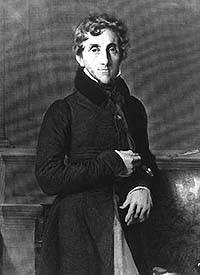- Louis, comte Molé
Infobox Prime Minister
name=Louis, comte Molé
order=18thPrime Minister of France
term_start =6 September 1836
term_end =31 March 1839
predecessor =Adolphe Thiers
successor =Duc de Dalmatie
order2=23rdPrime Minister of France
term_start2 =23 February 1848
term_end2 =24 February 1848
predecessor2 =François Guizot
successor2 =Jacques-Charles Dupont de l'Eure
birth_date =24 January 1781
death_date =death date and age|1855|11|23|1781|1|24|
party=Orleanist Louis Mathieu, comte Molé (24 January 1781 - 23 November 1855) was a French
statesman Biography
Molé was born in
Paris .His father, a president of the
parlement of Paris, who came of the family of the famous president noticed below, wasguillotine d during the Terror. Count Molé's early days were spent inSwitzerland and inEngland with his mother, a relative of Lamoignon-Malesherbes. On his return to France he studied at the Ecole Centrale des Travaux Publics, and his social education was accomplished in the salon of Pauline de Beaumont, the friend of Châteaubriand and Joubert. A volume of "Essais de morale et de politique" introduced him to the notice ofNapoleon , who attached him to the staff of the council of state. He became master of requests in 1806, and next year prefect of theCôte d'Or , Councillor of State and Director-General of Bridges and Roads in 1809, and Count of the Empire in the autumn of the same year.In November 1813 he became Minister of Justice. Although he resumed his functions as Director-General during the
Hundred Days , he excused himself from taking his seat in the Council of State and was apparently not seriously compromised, for Louis XVIII confirmed his appointment as Director-General and made him a peer of France. Molé supported the policy of the duc de Richelieu, who in 1817 entrusted to him the direction of the Ministry of Marine, which he held until December 1818.From that time he belonged to the moderate opposition, and he accepted the result of the revolution of 1830 without enthusiasm. He was Minister of Foreign Affairs in the first cabinet of Louis Philippe's reign, and was confronted with the task of reconciling the European powers to the change of government. The real direction of foreign affairs, however, lay less in his hands than in those of
Talleyrand , who had gone toLondon as the ambassador of the new king.After a few months in office Molé retired, and it was not until 1836 that the fall of Thiers led to his becoming Prime Minister of a new government, in which he held the portfolio of foreign affairs. One of his first actions was the release of the ex-ministers of Charles X, and he had to deal with the disputes with Switzerland and with the Strasburg coup of Louis-Napoléon. He withdrew the French garrison from
Ancona , but pursued an active policy inMexico and in Algeria.Personal and political differences rapidly arose between Molé and his chief colleague
Guizot , and led to an open rupture in March 1837 in face of the general opposition to a grant to the duc de Nemours. After some attempts to secure a new combination Molé resonstructed his ministry in April, Guizot being excluded. The general election in the autumn gave him no fresh support in the Chamber of Deputies, while he had now to face a formidable coalition between Guizot, the Left Centre under Thiers, and politicians of the Dynastic Left and the Republican Left. Molé, supported by Louis Philippe, held his ground against the general hostility until the beginning of 1839, when, after acrid discussions on the address, the chamber was dissolved. The new house showed little change in the strength of parties, but Molé resigned on 31 March 1839.A year later he was elected to the
Académie française , and though he continued to speak frequently he took no important share in party politics. Louis Philippe sought his help in his vain efforts to form a ministry in February 1848. After the revolution he was deputy for theGironde to the Constituent Assembly, and in 1849 to the Legislative Assembly, where he was one of the leaders of the Right until the coup d'état on the 2 December 1851 drove him from public life. He died at Champlâtreux (Seine-et-Oise ) on 23 November 1855.See
Paul Thureau-Dangin , "Histoire de la monarchie de juillet" (1884)References
Wikimedia Foundation. 2010.
